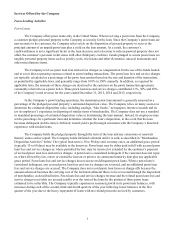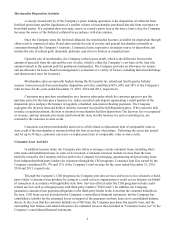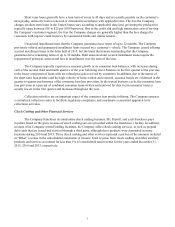Cash America 2015 Annual Report Download - page 19
Download and view the complete annual report
Please find page 19 of the 2015 Cash America annual report below. You can navigate through the pages in the report by either clicking on the pages listed below, or by using the keyword search tool below to find specific information within the annual report.
ITEM 1A. RISK FACTORS
The Company’s business and future results may be affected by a number of risks and uncertainties that
should be considered carefully in evaluating the Company. In addition, this report also contains forward-looking
statements that involve risks and uncertainties. The Company’s actual results could differ materially from those
anticipated in such forward-looking statements as a result of certain factors, including the risks faced by the
Company described below. The occurrence of one or more of the events listed below could also have a material
adverse effect on the Company’s business, prospects, results of operations, reputation, financial condition, cash
flows or ability to continue current operations without any direct or indirect impairment or disruption, which is
referred to throughout these Risk Factors as a “Material Adverse Effect.”
Risks Related to the Company’s Business and Industry
If the Company fails to comply with applicable laws, rules, regulations and guidance, such failure could have a
Material Adverse Effect.
If the Company fails to comply with applicable laws, rules, regulations and guidance, such failure could
have a Material Adverse Effect. The Company’s products and services are subject to extensive regulation,
supervision and licensing under various federal, state and local statutes, ordinances, regulations, rules and guidance.
These requirements generally mandate licensing or authorization as a pawnbroker, lender or as a credit service
organization or credit access business (“CSO”), establish limits on the amount, duration, renewals or extensions of
and charges for (including interest rates and fees) various categories of loans, direct the form and content of the
Company’s loan contracts and other documentation, restrict collection practices, outline underwriting requirements
and may subject the Company to periodic examination and ongoing supervision by regulatory authorities, among
other things. Because pawn loans and consumer loans, such as those provided by the Company, are viewed as
extensions of credit, the Company must comply with certain federal laws, such as the federal Truth in Lending Act
and its underlying regulations known as Regulation Z, the Equal Credit Opportunity Act, the Fair Credit Reporting
Act, the Fair and Accurate Credit Transactions Act, the Military Lending Act, the Servicemembers Civil Relief Act,
the Electronic Funds Transfer Act, the Gramm-Leach-Bliley Act, the USA PATRIOT Act, the Bank Secrecy Act, the
Brady Handgun Violence Prevention Act, Title X of the Dodd-Frank Act, and the Fair Debt Collection Practices Act
with respect to the Company’s CSO programs, among other laws. In addition, the Company’s marketing efforts and
the representations made about its products and services are subject to federal and state unfair and deceptive
practice statutes, including the Federal Trade Commission Act and analogous state statutes under which the Federal
Trade Commission, state attorneys general or private plaintiffs may bring legal actions. Compliance with applicable
laws, regulations, rules and guidance requires forms, processes, procedures, training, controls and the infrastructure
to support these requirements. Compliance may also create operational constraints, be costly or adversely affect
operating results. See “Item 1. Business—Regulation” for a more detailed discussion of the laws applicable to the
Company.
The Company’s failure to comply with applicable laws, rules, regulations and guidance, or any finding that
the Company’s past forms, practices, processes, procedures, controls or infrastructure were insufficient or not in
compliance, could subject the Company to regulatory enforcement actions, result in the assessment against it of
civil, monetary, criminal or other penalties (some of which could be significant in the case of knowing or reckless
violations), result in the issuance of cease and desist orders (which can include orders for restitution or rescission of
contracts, as well as other kinds of affirmative relief), require the Company to refund interest or fees, result in a
determination that certain loans are not collectible, result in a revocation of licenses or authorization to transact
business, result in a finding that it has engaged in unfair and deceptive practices, result in consumer litigation
(including class action lawsuits), limit the Company’s access to services provided by third-party financial
institutions or cause damage to the Company’s reputation, brands and valued customer relationships. From time to
time the Company becomes aware of instances where its products and services have not fully complied with
requirements under applicable laws and regulations or applicable contracts. Determinations of compliance with
applicable requirements or contracts, such as those applicable to the Company, can be highly technical and subject
to varying interpretations. When the Company becomes aware of such an instance, whether as a result of its
15
























